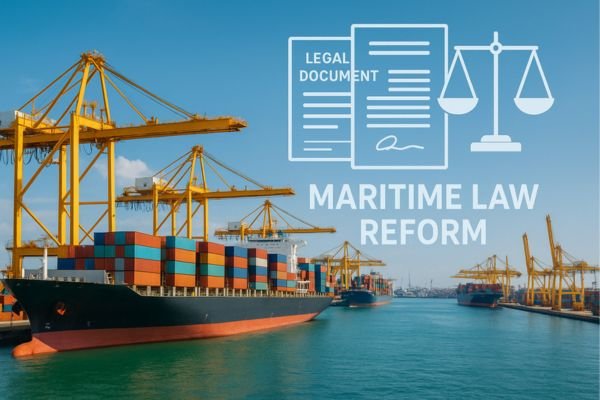Carriage of Goods by Sea Bill 2025 – 8 Powerful Reforms & 4 Critical Drawbacks Shaping India’s Maritime Trade
India’s Carriage of Goods by Sea Bill, 2025: A landmark maritime legal reform The Indian Parliament recently passed the Carriage of Goods by Sea Bill, 2025, enacting a significant reform in the country’s maritime legal landscape. This new legislation replaces the century-old Indian Carriage of Goods by Sea Act, 1925, a colonial-era law deemed outdated and incompatible with modern global maritime trade practices. 🧭 Introduction Overview of the Carriage of Goods by Sea Bill, 2025 The Carriage of Goods by Sea Bill, 2025 – Maritime Legal Reform marks a significant turning point for India’s shipping and logistics sector. Designed to replace the nearly century-old Carriage of Goods by Sea Act, 1925, this bill modernises the legal framework that governs how goods are transported by sea, the rights and liabilities of carriers and shippers, and the handling of disputes. With India’s maritime trade volume steadily increasing, this bill ensures our laws align with global standards and meet the needs of a modern economy. Why This Maritime Reform Matters for India’s Shipping Industry Maritime transport is the backbone of international trade, and outdated laws can hinder efficiency, competitiveness, and compliance. The Carriage of Goods by Sea Bill, 2025 – Maritime Legal Reform is crucial because it: ⚖️ Background & Need for Reform Existing Laws Governing Carriage of Goods by Sea in India Currently, India’s sea trade is regulated under the Carriage of Goods by Sea Act, 1925, based largely on the Hague Rules of 1924. While functional for its time, the act has not kept pace with changes in shipping technology, logistics operations, and international conventions. Limitations of the Carriage of Goods by Sea Act, 1925 Some of the major shortcomings include: Global Maritime Trends Prompting Legal Changes The rise of containerisation, digital documentation, and complex supply chains has pushed nations to adopt newer legal frameworks like the Hague-Visby Rules, Hamburg Rules, and Rotterdam Rules. India’s Carriage of Goods by Sea Bill, 2025 is a response to these trends, ensuring our maritime trade remains competitive and globally aligned. 📜 Key Provisions of the Carriage of Goods by Sea Bill, 2025 Scope and Applicability of the New Bill The bill applies to contracts for the carriage of goods by sea where: It also covers both liner and tramp shipping services, expanding applicability beyond the 1925 Act. Updated Rights and Obligations of Carriers and Shippers Changes in Bill of Lading Rules The bill recognises electronic bills of lading as legally valid documents, in line with global digitalisation trends. It also updates provisions on negotiability, transfer, and evidence of cargo receipt. Revised Liability Limits for Carriers Carrier liability for cargo loss or damage is increased to match international norms—calculated either per package/unit or per kilogram of cargo weight, whichever is higher. Provisions on Delivery of Goods & Claims Process Clearer timelines are set for delivery and for lodging claims in case of loss or damage, reducing uncertainty for all parties involved. 🌐 Alignment with International Conventions How the Bill Aligns with the Hague-Visby Rules / Hamburg Rules / Rotterdam Rules The Carriage of Goods by Sea Bill, 2025 borrows key principles from: Impact on India’s Compliance with Global Maritime Standards By aligning with these conventions, the bill makes Indian shipping contracts more predictable and acceptable in global trade, encouraging foreign carriers and investors to operate in India. 🚢 Impact on Stakeholders Benefits for Shipowners & Carriers Changes for Exporters & Importers Implications for Freight Forwarders and Logistics Companies 💼 Dispute Resolution & Legal Remedies Jurisdiction and Arbitration Clauses under the New Bill The bill clearly defines jurisdiction for disputes and allows for arbitration, both domestic and international, in line with global shipping practices. Changes in Time Limits for Filing Claims The claim filing period is extended in certain cases, ensuring shippers have reasonable time to detect and report cargo damage or loss. 📊 Economic & Trade Impact Boost to India’s Shipping Industry By modernising legal processes and aligning with global norms, India positions itself as a competitive player in international shipping, attracting more business to Indian ports. Impact on Freight Costs and Trade Competitiveness While higher liability limits may slightly increase freight insurance costs, the overall efficiency gains and reduced disputes are expected to lower total trade costs in the long run. 🔍 Comparison: Old Act vs New Bill (2025) Feature Carriage of Goods by Sea Act, 1925 Carriage of Goods by Sea Bill, 2025 International Alignment Hague Rules 1924 Hague-Visby, Hamburg, Rotterdam Liability Limits Outdated Updated to global standards Bill of Lading Paper only Paper & electronic recognised Multimodal Transport Not covered Explicitly recognised Dispute Resolution Limited Clear arbitration & jurisdiction rules 🧠 Expert Insights & Legal Analysis Why the 2025 Bill Is a Step Towards Modern Maritime Governance Legal experts view the Carriage of Goods by Sea Bill, 2025 – Maritime Legal Reform as essential for removing outdated legal bottlenecks and making India’s maritime trade ecosystem more competitive. Challenges in Implementation 📌 Conclusion Carriage of Goods by Sea Bill, 2025 – The Road Ahead The bill is a proactive step towards building a more transparent, efficient, and globally integrated maritime legal system. What Businesses Should Do to Stay Compliant 📝 FAQs When will the Carriage of Goods by Sea Bill, 2025 come into effect?The government is expected to notify the commencement date after passing in Parliament, likely in late 2025. Does the Bill apply to domestic coastal shipping?Yes, where the contract specifies that the bill applies to domestic sea carriage. What are the new liability limits for carriers?They are aligned with the Hague-Visby Rules—calculated per package or per kilogram of cargo weight. How does the Bill impact small exporters?Small exporters benefit from clearer rules, stronger cargo protection, and faster dispute resolution, making international trade easier.





